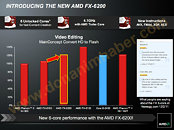Wednesday, December 14th 2011

AMD Gives Bulldozer 6-core a Speed-Bump with FX-6200
AMD launched its AMD FX processor family with two eight-core parts (FX-8150, FX-8120), a six-core part (FX-6100), and a quad-core one (FX-4100), apparently a newer, slightly faster six-core FX processor is just around the corner, the FX-6200. Since all AMD FX processors are unlocked out of the box, the FX-6200 is essentially a speed-bump. Out of the box, it is clocked at 3.80 GHz, with 4.10 GHz maximum TurboCore speed. It features six cores, 6 MB total L2 cache, and 8 MB total L3 cache. Its TDP is rated at 125W. In a presentation to retailers sourced by DonanimHaber, AMD pitched the FX-6200 to have about 10% higher performance at Mainconcept HD to Flash conversion, than the FX-6100 (3.30 GHz nominal, 3.90 GHz max. turbo).
Source:
DonanimHaber

79 Comments on AMD Gives Bulldozer 6-core a Speed-Bump with FX-6200
It's simple: BD's single core performance is worse than that of PhII's, but it has more cores. So, it performs worse in less-threaded applications and better in well-threaded ones. (In case the clocks are similar.)
Notice that this application can clearly make good use of 8 threads - the HT enabled i7 thrashes the otherwise near-identical i5.
Another example is F@H. Also, notice that Microsoft's Windows 7 patch today acknowledges this point - it makes sure that tasks are spread between BD modules to avoid bottlenecks.